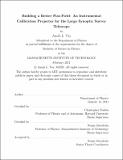Building a better flat-field : an instrumental calibration projector for the Large Synoptic Survey Telescope
Author(s)
Vaz, Amali L
DownloadFull printable version (29.93Mb)
Alternative title
Instrumental calibration projector for the Large Synoptic Survey Telescope
Other Contributors
Massachusetts Institute of Technology. Dept. of Physics.
Advisor
Christopher Stubbs and Nergis Mavalvala.
Terms of use
Metadata
Show full item recordAbstract
The Large Synoptic Survey Telescope (LSST) is a next-generation ground-based survey telescope whose science objectives demand photometric precision at the 1% level. Recent efforts towards 1% photometry have advocated in-situ instrumental calibration schemes that use a calibrated detector, rather than a celestial source, as the fundamental reference point for all measurements of system throughput. Results have been promising, but report systematic errors due to stray and scattered light from the flat-field screens used. The LSST calibration scheme replaces the traditional Lambertian-scattering flat-field screen with an array of projectors whose light is constrained in angle, thereby minimizing scattered light incident on the detector. This thesis presents the construction and testing of a single prototype projector within the LSST array. In particular, we evaluate the use of Engineered Diffusers to define the angular radiance of incident light, and of either a Fresnel lens or parabolic mirror to collimate that light. We find that flat-top Engineered Diffusers produce light that is constrained in angle, but which shows persistent pixel-to-pixel non-uniformity at the 5-10% level, and colorto- color non-uniformity at the 5-15% level; unless compensated, chromatic non-uniformity renders them unsuitable for our purposes. The additional chromatic aberrations introduced by Fresnel lens collimators render such transmissive collimators infeasible. Nevertheless, we demonstrate the soundness of the flat-field projector concept by constructing an alternative projector prototype, based on an integrating sphere, that satisfies each criterion well within our tolerances. The magnitude of improvement granted by the integrating sphere projector suggests that future work further investigate this approach.
Description
Thesis (S.B.)--Massachusetts Institute of Technology, Dept. of Physics, 2011. This electronic version was submitted by the student author. The certified thesis is available in the Institute Archives and Special Collections. Cataloged from student submitted PDF version of thesis. Includes bibliographical references (p. 125-126).
Date issued
2011Department
Massachusetts Institute of Technology. Department of PhysicsPublisher
Massachusetts Institute of Technology
Keywords
Physics.